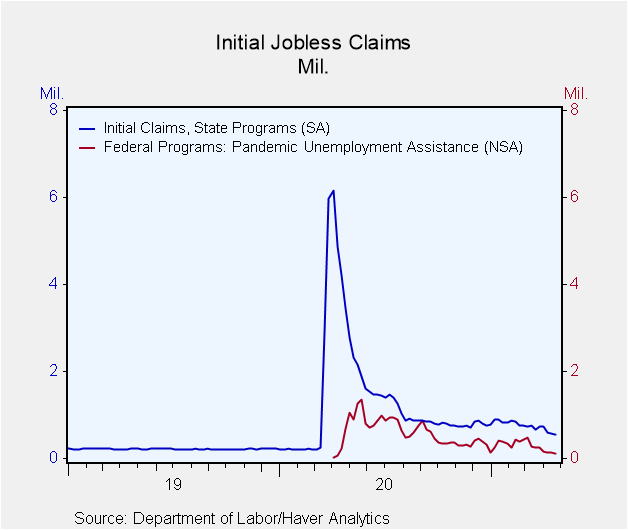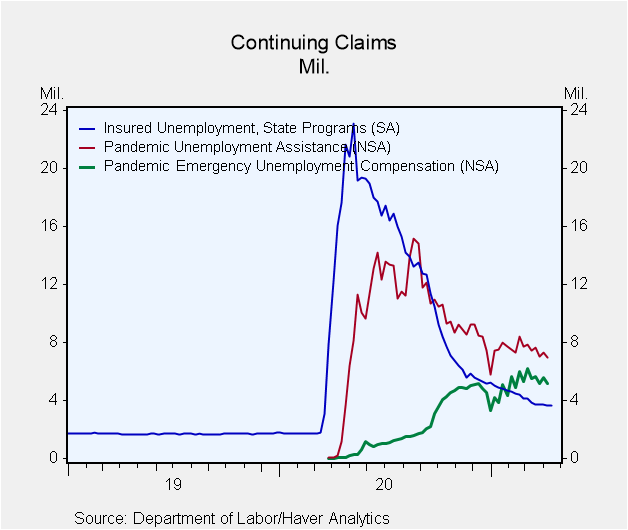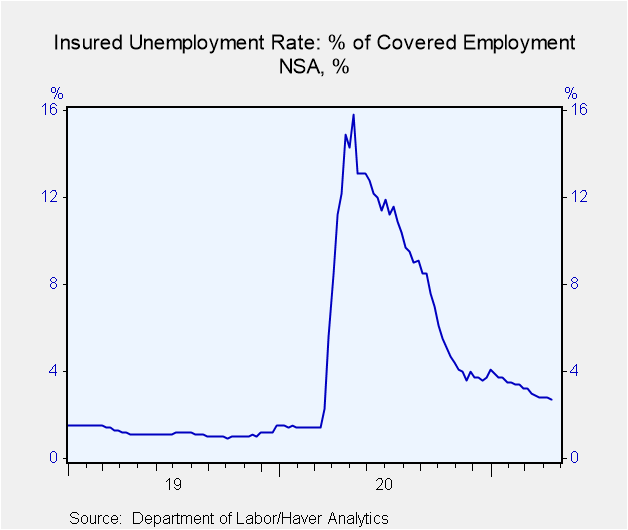 Global| Apr 29 2021
Global| Apr 29 2021U.S. Initial Unemployment Insurance Claims Fell Further
by:Sandy Batten
|in:Economy in Brief
Summary
• Both initial state claims and PUA claims fell to pandemic lows. • Continuing state claims essentially unchanged at pandemic low. • Continuing claims for PUA and PEUC benefits both decline. Initial claims for unemployment insurance [...]
• Both initial state claims and PUA claims fell to pandemic lows.
• Continuing state claims essentially unchanged at pandemic low.
• Continuing claims for PUA and PEUC benefits both decline.
Initial claims for unemployment insurance continued to decline in the week ending April 24, falling to 553,000, down 13,000 from the prior week’s 566,000 (revised up from 547,000). The Action Economics Forecast Survey panel expected that 563,000 new claims would be filed. The latest week’s figure represents yet another new low since the pandemic started in March 2020, even though it is still well above pre-pandemic levels. The 4-week moving average fell to 611,750 in the week ended April 24, also a pandemic low, from 655,750 the previous week.
Initial claims for the federal Pandemic Unemployment Assistance (PUA) program fell to 121,749 in the April 24 week, down from 133,358 the week before. Still, these are both the smallest since April 11, 2020, right after the program began. The PUA program provides benefits to individuals who are not eligible for normal state unemployment insurance benefits, such as the self-employed. Given the brief history of this program, these and other COVID-related series are not seasonally adjusted.
Continuing claims for regular state unemployment insurance edged up 9,000 to 3.66 million in the week ended April 17 from 3.65 million in the previous week (revised from 3.67 million). The state insured rate of unemployment was unchanged at 2.6%. The 2.6% rate is also the lowest since the pandemic started; it was as high as 15.9% in May 2020.
Continuing PUA fell markedly in the week ended April 10, to 6.97 million from 7.31 million. Still, this is the lowest since the first few weeks of the pandemic period, except for a temporary dip during the week between Christmas and New Year’s. Also in the April 10 week, the number receiving Pandemic Emergency Unemployment Compensation (PEUC) fell sharply to 5.19 million from 5.61 million in the prior week. This program covers people who have exhausted their state benefits.
The total number of all state, federal, and PUA and PEUC continuing claims fell to 16.01 million in the week ended April 10, down 823,000 from the previous week. This is also the lowest since very early in the pandemic period, except for the week after Christmas. This grand total is not seasonally adjusted.
The state insured rates of unemployment continued to vary widely. In the week ending April 10, the highest insured unemployment rates were in Nevada (5.83%), Connecticut (5.31%), Alaska (4.91%), New York (4.60%) and Illinois (4.28%). The lowest rates were in Kansas (0.67%), South Dakota (0.76%), Utah (0.81%), Kentucky (0.83%) and Nebraska (0.90%). Insured unemployment rates in other large states included California (3.48%), Texas (2.36%) and Florida (1.48%). These state rates are not seasonally adjusted.
Data on weekly unemployment claims going back to 1967 are contained in Haver's WEEKLY database, and they are summarized monthly in USECON. Data for individual states are in REGIONW. The expectations figure is from the Action Economics Forecast Survey, carried in the AS1REPNA database.
| Unemployment Insurance (SA, 000s) | 04/24/21 | 04/17/21 | 04/10/21 | Y/Y % | 2020 | 2019 | 2018 |
|---|---|---|---|---|---|---|---|
| Initial Claims | 553 | 566 | 586 | -84 | 1,352 | 218 | 220 |
| Initial Claims (NSA) | 575 | 585 | 623 | -83 | 1,353 | 218 | 221 |
| Initial Claims Pandemic Unemployment Assistance (NSA) | 122 | 133 | 130 | -- | -- | -- | -- |
| Continuing Claims | -- | 3,660 | 3,651 | -79 | 10,380 | 1,699 | 1,754 |
| Continuing Claims (NSA) | -- | 3,791 | 3,840 | -79 | 10,370 | 1,704 | 1,763 |
| Continuing Claims Pandemic Unemployment Assistance (NSA) | -- | -- | 6,974 | -- | -- | -- | -- |
| Insured Unemployment Rate (%) | 2.6 | 2.6 |
12.4 |
7.1 | 1.2 | 1.2 |
Sandy Batten
AuthorMore in Author Profile »Sandy Batten has more than 30 years of experience analyzing industrial economies and financial markets and a wide range of experience across the financial services sector, government, and academia. Before joining Haver Analytics, Sandy was a Vice President and Senior Economist at Citibank; Senior Credit Market Analyst at CDC Investment Management, Managing Director at Bear Stearns, and Executive Director at JPMorgan. In 2008, Sandy was named the most accurate US forecaster by the National Association for Business Economics. He is a member of the New York Forecasters Club, NABE, and the American Economic Association. Prior to his time in the financial services sector, Sandy was a Research Officer at the Federal Reserve Bank of St. Louis, Senior Staff Economist on the President’s Council of Economic Advisors, Deputy Assistant Secretary for Economic Policy at the US Treasury, and Economist at the International Monetary Fund. Sandy has taught economics at St. Louis University, Denison University, and Muskingun College. He has published numerous peer-reviewed articles in a wide range of academic publications. He has a B.A. in economics from the University of Richmond and a M.A. and Ph.D. in economics from The Ohio State University.










